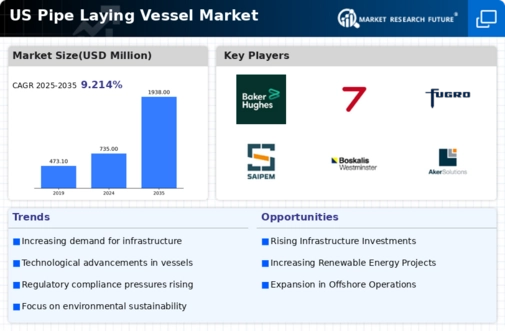Rising Energy Sector Investments
The energy sector in the US is experiencing a notable transformation, with significant investments directed towards renewable energy sources and traditional oil and gas exploration. The US Energy Information Administration projects that renewable energy will account for 50% of the electricity generation by 2030. This shift necessitates the installation of extensive pipeline networks to transport energy resources efficiently. Consequently, the pipe laying-vessel market is likely to benefit from increased demand for specialized vessels capable of laying pipelines for both renewable and non-renewable energy projects. The integration of advanced technologies in these vessels enhances their operational efficiency, making them indispensable in meeting the energy sector's evolving needs.
Growing Importance of Offshore Projects
The growing focus on offshore projects, particularly in the oil and gas sector, is a significant driver for the pipe laying-vessel market. This focus necessitates advanced vessels capable of operating in challenging offshore environments.. The US has vast offshore reserves that require extensive pipeline networks for resource extraction and transportation. As exploration activities expand into deeper waters, the need for specialized pipe laying vessels capable of operating in challenging offshore environments becomes critical. The Bureau of Ocean Energy Management indicates that offshore oil production is projected to increase, necessitating advanced vessels that can efficiently lay pipelines under complex conditions. This trend is likely to bolster the pipe laying-vessel market as companies invest in modern fleets to meet the demands of offshore projects.
Environmental Regulations and Compliance
The increasing stringency of environmental regulations in the US is shaping the pipe laying-vessel market. Regulatory bodies are imposing stricter guidelines on emissions and environmental impact assessments, compelling companies to adopt more sustainable practices. This shift is prompting the development of eco-friendly vessels that minimize environmental footprints during operations. Compliance with these regulations not only ensures legal adherence but also enhances corporate reputation, which is becoming increasingly important in the industry. As a result, the demand for vessels equipped with advanced environmental management systems is likely to rise, thereby influencing the overall dynamics of the pipe laying-vessel market.
Technological Innovations in Vessel Design
Technological advancements in vessel design and construction are significantly influencing the pipe laying-vessel market. Innovations such as dynamic positioning systems, automated pipe handling, and enhanced stability features are improving the efficiency and safety of pipe laying operations. These advancements allow vessels to operate in deeper waters and harsher environments, expanding the scope of potential projects. The market is witnessing a trend towards the development of hybrid vessels that combine traditional and renewable energy sources, which could reduce operational costs and environmental impact. As companies seek to enhance their competitive edge, investment in cutting-edge technology is likely to drive growth in the pipe laying-vessel market.
Increasing Demand for Infrastructure Development
The ongoing expansion of infrastructure projects in the US is a primary driver for the pipe laying-vessel market. With the government investing heavily in upgrading transportation networks, water supply systems, and energy infrastructure, the demand for efficient pipe laying solutions is surging. The American Society of Civil Engineers estimates that the US requires an investment of approximately $4 trillion by 2025 to maintain and improve its infrastructure. This creates a favorable environment for the pipe laying-vessel market, as these vessels are essential for the timely and effective installation of pipelines. As projects increase in scale and complexity, the need for advanced pipe laying vessels that can operate in challenging conditions becomes more pronounced, thereby propelling market growth.





















Leave a Comment